|
JAISALMER
I was not in any hurry to leave this remote and beautiful desert town
.. close to Rajasthan's border with Pakistan, and located on what was once
the medieval silk route linking India to Egypt, Arabia, Persia, Africa and
the West, it was a marvelously rewarding travel experience.
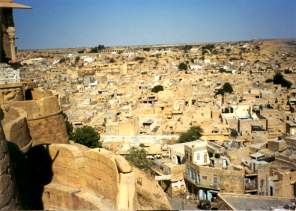
Founded in the 12th century as a staging post for camel trains travelling
between India and Central Asia, Jaisalmer is a golden sandstone town with
crumbling city walls, a magnificent fortress and a number of exquisitely
carved stone and wooden havelis (residential buildings).
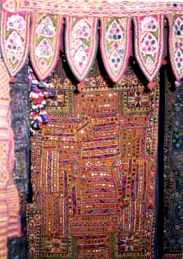 Every
evening, sunsets contribute to priceless views, bathing the fort and the
city in golden-orange hues. Rawal Jaisal, a descendent of the Yadav Clan
and a Bhatti Rajput, laid the foundation of this city in 1156 A.D. after
abandoning his old fort at Lodurva (17 kms. away, the 4th century torana
in the temple here is a must see) and established this new capital. The
Bhati Rajputs of Jaisalmer were feudal chiefs who lived on the forced levy
on the caravans that crossed their territory en-route to Delhi. These
caravans, laden with precious cargo of spices and silk, brought great
wealth to this town. Because of its remote location, Jaisalmer for years
remained untouched by outside influences and in fact, during the British
Raj, the rulers of Jaisalmer were the last to sign the instrument of
agreement with the British. Every
evening, sunsets contribute to priceless views, bathing the fort and the
city in golden-orange hues. Rawal Jaisal, a descendent of the Yadav Clan
and a Bhatti Rajput, laid the foundation of this city in 1156 A.D. after
abandoning his old fort at Lodurva (17 kms. away, the 4th century torana
in the temple here is a must see) and established this new capital. The
Bhati Rajputs of Jaisalmer were feudal chiefs who lived on the forced levy
on the caravans that crossed their territory en-route to Delhi. These
caravans, laden with precious cargo of spices and silk, brought great
wealth to this town. Because of its remote location, Jaisalmer for years
remained untouched by outside influences and in fact, during the British
Raj, the rulers of Jaisalmer were the last to sign the instrument of
agreement with the British.
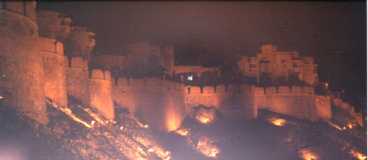 Jaisalmer's
importance faded when sea trade (namely through the western ports of
Bombay & Surat) replaced the old land routes. The narrow streets in the
walled city preserve a traditional way of life : the craftsmen still work
at the ancient crafts of weaving and stone carving, the making of silver
jewellery and embroidery. And the stately, nonchalant camel is everywhere. Jaisalmer's
importance faded when sea trade (namely through the western ports of
Bombay & Surat) replaced the old land routes. The narrow streets in the
walled city preserve a traditional way of life : the craftsmen still work
at the ancient crafts of weaving and stone carving, the making of silver
jewellery and embroidery. And the stately, nonchalant camel is everywhere.
I never tired of walking through the narrow sandstone streets savouring
the colours, artistry on display, warmth & hospitality of the people
there. I'd been warned that temperatures here could sometimes fall to 0
degrees C! And we sure did have a couple of chilly nights in January!
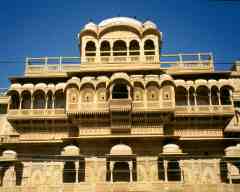
One strange sight (and sound) was that of the Mirage jet bombers doing
their daily practice runs in the skies over this otherwise quiet and laid
back town. (There is an air-force base in Ramgad, fairly close by, and
Jaisalmer is not far from the Indo-Pak border). Jaisalmer's surroundings
date back to the Indus Valley Civilization. For the archaeology
enthusiast, there are several protected ancient site remains to drool
over. There is also a Wood Fossil Park (17 km from Jaisalmer) which
has fossils dating back to 180 million years. For the nature lover, there
is the Desert National Park (40 km. from Jaisalmer, adjacent to
Sam) where you can see monitor lizards, chital or deer, desert foxes,
porcupine, occasional wolves and black bucks, and the Great Indian Bustard
(a protected bird).
Jaisalmer was the furthest I'd come north-west, deep into the heart of the
Thar desert. It certainly wasn't barren and desolate, on the contrary,
this frontier town seemed to court some of the happiest tourists in India!
There was much to do here, and when wanting to relax my feet and catch my
breath, I'd just pop into one of the shops on the way, and within a few
minutes, be absorbed in an interesting dialogue with the owner, who would
first ply you with either a cup of tea, or some freshly made delicious
'red' carrot juice! In Jaisalmer, I discovered, you'd go into shops as a
customer, but leave as a friend - and no - I was never forced to buy
anything, though I voluntarily did come away with my arms full!
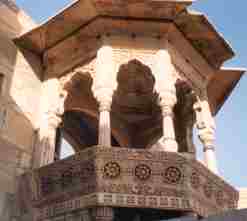
Jaisalmer Fort
This fort is certainly one of the finest I've seen in India. Built in
the 11th century of golden-yellow sandstone, above the 80m high Trikuta
Hill, it has 99 turrets, and within it lies the old city, where nearly
12,000 people still reside today within its walls.
Approached through a series of 4 huge gates, the fort is a maze of small
winding lanes, initially flanked by touristy shops, little child-musicians
colourfully dressed and performing
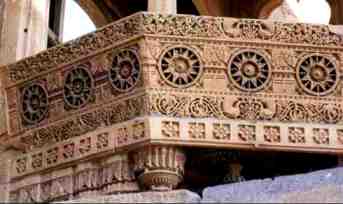 traditional
songs & dances. women selling imitation silver jewelry. The Fort houses a
maharaja's palace, a ceremonial courtyard and beautifully carved Jain
temples. traditional
songs & dances. women selling imitation silver jewelry. The Fort houses a
maharaja's palace, a ceremonial courtyard and beautifully carved Jain
temples.
The rich merchants of yore engaged stone craftsmen who, in my mind must
have been singularly obsessed about filling up all the panels, mansion
walls and balconies with delicate sculptural filigree, ornamental screen
windows, and elaborate lace-like detail. Today, these mansions are still
inhabited, and some have been converted into hotels enabling tourists to
get a feel of what living in an ancient fort would be like.
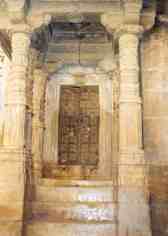 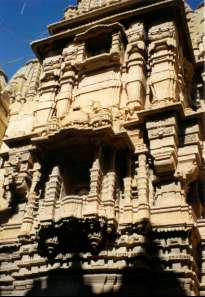 Walking
through these ancient quarters is a wonderful experience .. life goes on
as usual, women scrubbing their vessels till they shone, preparing the
day's meal, drying their long tresses in the hot desert sun, children
playing in the narrow alleyways, adorable baby goats and benign cows
sauntering past you, temple bells clanging, the lone voice of a desert
musician emanating from some lonely corner of the fort... Walking
through these ancient quarters is a wonderful experience .. life goes on
as usual, women scrubbing their vessels till they shone, preparing the
day's meal, drying their long tresses in the hot desert sun, children
playing in the narrow alleyways, adorable baby goats and benign cows
sauntering past you, temple bells clanging, the lone voice of a desert
musician emanating from some lonely corner of the fort...
Jain Temples
Just follow the line of tourists, and you'll eventually get to the
Jain temples. This group of temples were built in the 12th to 15th
century. They are beautifully carved and dedicated to the saints
Rikhabdevji and Sambhavnathji. The Gyan Bhandar, a library containing some
extremely old manuscripts, is within the temple complex.
 Gadsisar
Sagar Tank Gadsisar
Sagar Tank
A 20 minute walk from the city core, lies the Gadsisar Tank. This
tank, south of the city walls, was once the water supply of the city and
there are many small temples and shrines around the tank. In winter a wide
variety of water birds flock here.
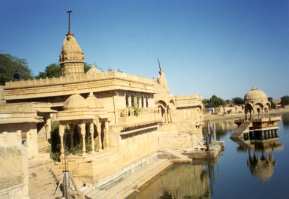 The
beautiful arched gateway across the road down to the tank is said to have
been built by a famous prostitute. The
beautiful arched gateway across the road down to the tank is said to have
been built by a famous prostitute.
Apparently when she built it, the locals were not too happy with it - what
with she being a prostitute and all, besides they would have to pass under
its arches on the way down to the tank and that, they felt, would be
unseemly. So they convinced the king to tear it down.
While he was away she re-built the gate anyway and with some clever
thinking on her part, crowned it with a temple dedicated to the Hindu
deity Krishna. Of course, nobody desecrates a holy place of worship.
So it still stands there today, and I'm glad it does. It's a real peaceful
place. |
|
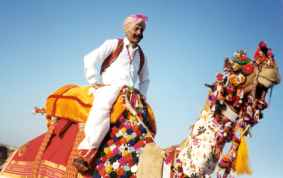 Jaisalmer's
Desert Festival Jaisalmer's
Desert Festival
I was fortunate to have been here during the 3-day desert festival. It is
held once a year in the winter, coinciding with the full moon, and is one
of the most colourful events in India.
 Exciting
competitions and contests especially the turban-tying contest, Mr. Desert
contest and camel races enlighten the festivities. I had long wanted to
see a game of camel polo, and that wish was fulfilled here! Not only were
the camels in no mood to run after the ball and follow their riders
directions, I think I saw a few bored ones deliberately kick it out of the
demarcated boundary lines! Exciting
competitions and contests especially the turban-tying contest, Mr. Desert
contest and camel races enlighten the festivities. I had long wanted to
see a game of camel polo, and that wish was fulfilled here! Not only were
the camels in no mood to run after the ball and follow their riders
directions, I think I saw a few bored ones deliberately kick it out of the
demarcated boundary lines!
 I
enjoyed the craft bazaars, folk dances, and the art of traditional balled
singing was evident everywhere. Jaisalmer even has a 'musicians colony'. I
enjoyed the craft bazaars, folk dances, and the art of traditional balled
singing was evident everywhere. Jaisalmer even has a 'musicians colony'.
 Indian
marching bands are a pretty colourful sight, though I saw many a puzzled
tourist when bagpipe-playing soldiers dressed in Scottish kilts &
elaborate turbans marched smartly by! Indian
marching bands are a pretty colourful sight, though I saw many a puzzled
tourist when bagpipe-playing soldiers dressed in Scottish kilts &
elaborate turbans marched smartly by!
Jaisalmer is the only place in India that I know of, that has a camel
contingent as part of the BSF (Indian Border Security Forces). During the
Festival, scores of them were part of parades, exhibitions and programmes,
and were decked out in all their finery, down to their ankles! In everyday
life though, they are used to pull carts and transport goods, and in the
tourist season, to transport tourists. Camel milk is drunk here, and camel
dung used as firewood.
Sam Sand Dunes
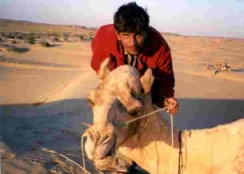 I
visited Sam (pronounced 'suhm') one evening- the orange sunset was to give
way to a brilliant full moon night. About 40 kms. away from Jaisalmer, Sam
is an oft-visited place by tourists, since it is famous for its long
dunes, and incredible sunsets. On arrival, (it's like arriving nowhere
actually, since you are surrounded by an infinite stretch of desert), you
are greeted by a dozen camel keepers, offering to take you to the dunes
and back. I chose one of them at random, actually he was the most
persistent one, and I heaved myself up on to my camel's back. What a
wonderful trek into the desert! It was cool, quiet, and relaxing. Until I
discovered that my camel had been christened Michael Jackson. Ooops - I'm
not too keen on witnessing any break-dances here - camels are notorious
for their rebellious and unpredictable nature. I was more wary of him
after that - but he turned out to be a real decent bloke. Even allowed me
to pat and hug him after the trek! I
visited Sam (pronounced 'suhm') one evening- the orange sunset was to give
way to a brilliant full moon night. About 40 kms. away from Jaisalmer, Sam
is an oft-visited place by tourists, since it is famous for its long
dunes, and incredible sunsets. On arrival, (it's like arriving nowhere
actually, since you are surrounded by an infinite stretch of desert), you
are greeted by a dozen camel keepers, offering to take you to the dunes
and back. I chose one of them at random, actually he was the most
persistent one, and I heaved myself up on to my camel's back. What a
wonderful trek into the desert! It was cool, quiet, and relaxing. Until I
discovered that my camel had been christened Michael Jackson. Ooops - I'm
not too keen on witnessing any break-dances here - camels are notorious
for their rebellious and unpredictable nature. I was more wary of him
after that - but he turned out to be a real decent bloke. Even allowed me
to pat and hug him after the trek!

Of course, the sunset at Sam was out-of-this-world. I spent this time in
the quiet of the desert, interrupted by Michael Jackson's soft
harrumphings. The sand dunes kept changing colour, shadows shifting by the
minute. My camel keeper, who must have witnessed this everyday of his
life, sat in quiet wonder, and we bade goodbye to the mighty orange ball -
the giver of life. Later, in the soft breeze along the desert horizon, I
was part of a train of camels that trudged back to the waiting cars and
buses in the distance. The big pearly full moon was already rising
high in the night sky, illuminating the dunes and the vast sands beyond.
|